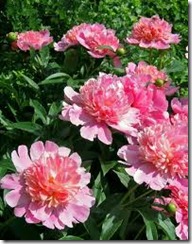Peonies, with deep green, divided leaves and showy flowers, are divided into two groups. Herbaceous peonies grow 2 to 4 feet high, and their spectacular flowers grow up to 10 inches across. Tree peonies, however, are actually shrubs. Often 6 feet tall, tree peonies have even larger blooms than herbaceous peonies. Growers cherish both varieties, and gardeners established North American peony societies over a century ago.
History
-
Merchant sailors brought rare plant from Asia.
Peonies are native to China and were cultivated in the fourth century A.D. In 1656, merchants from the Dutch East India Company mentioned the peony to European growers, boasting that these flowers were larger than the thorny rose. Empress Joséphine, in France, and James Kelway, an English plant collector, popularized the peony in the 1800s. Peonies traveled with pioneers across North America in the 1850s.
Culture
-
 Peonies have double or single flowers.
Peonies have double or single flowers.Long-lived and hardy, peonies grow best in cooler climates. Peonies prefer full sun but require winter chill to produce flowers. Peony roots rot in slow-draining soils; plant peonies in raised beds if necessary. New gardeners often plant herbaceous peonies too deep, with the eyes of the tuber more than 2 inches below ground level. These peonies will not flower for many years. Fertilize herbaceous peonies with a slow-release, low-nitrogen fertilizer when the spring shoots are 3 inches high. In late fall, cut herbaceous peony stems to 3 inches above the ground. Do not prune tree peonies.
Ants
-
 Ants do not harm peony buds.
Ants do not harm peony buds.Ants are a trademark of peony buds, but are not necessary to open the flowers. The peony buds produce sweet nectar which attracts the insects. The ants are not harmful, according to the Heartland Peony Society, and insecticides are not recommended. The ants disappear as the flowers open.
Transplanting
-
Do not disturb a peony if possible. If transplanting is unavoidable, such as moving it from a shady area or redesigning the garden, transplant a peony in September. The Iowa State University Extension recommends cutting a herbaceous peony’s stem to ground level before digging around and under the plant, keeping the majority of the roots intact. Replant the root ball immediately. Transplanted peonies have fewer blooms, if any, the following season and may take years to fully recover.
Diseases
-
 Unsanitized pruning shears transfer disease.
Unsanitized pruning shears transfer disease.Botrytis blight, a fungus, affects buds in midsummer, turning them black and soft. Leaf spots are also caused by fungi, but the damage is cosmetic. Phytophthora blight kills peonies, however, and this fungus turns buds and stems dark and leathery. Any fungal spores overwinter in fallen peony leaves, but proper sanitation prevents most problems before they start. Prune and dispose of affected leaves or buds; don’t compost diseased clippings. Sanitize pruning shears with a 10 percent bleach solution after cutting diseased plants.


Deprecated: strpos(): Passing null to parameter #1 ($haystack) of type string is deprecated in /home/agriviek8Qv/agriviet.net/public_html/wp-includes/comment-template.php on line 2522